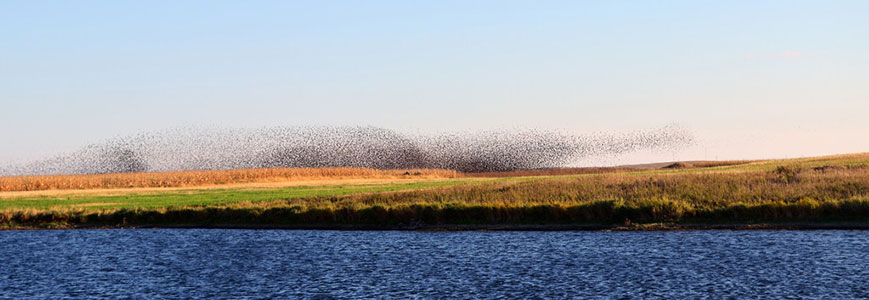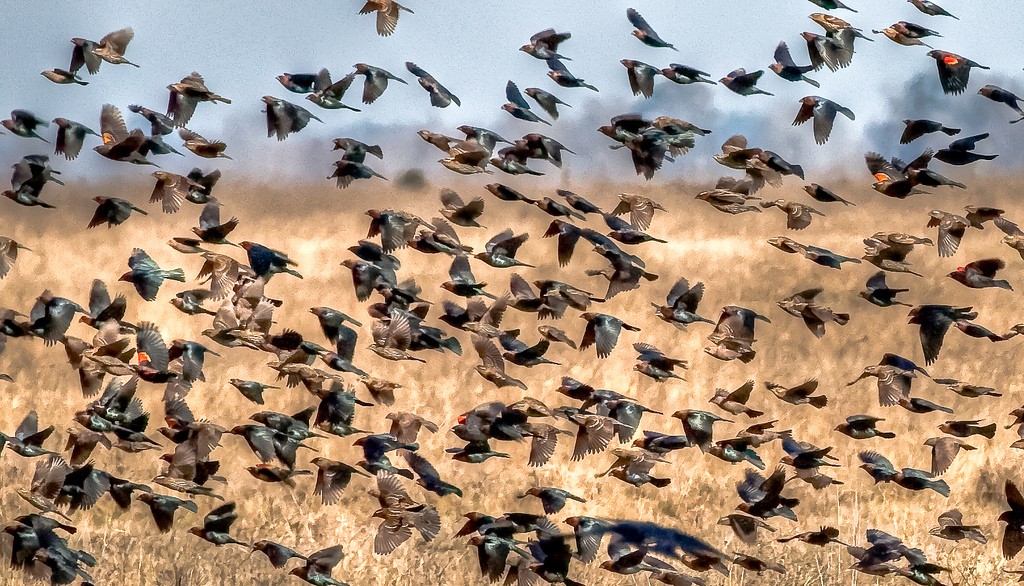Magnificent migrants

Red-winged blackbirds on the horizon. Photo: U.S. Fish and Wildlife Service
With all due respect to synchronized swimmers, a flock of thousands of blackbirds turning and wheeling in unison is even more impressive. Yes, blackbird migration is underway. Although grackles, cowbirds, and the invasive starlings are lumped into the category of blackbird, it’s our native red-winged blackbird I see more often.
Considering red-wing blackbirds are the most numerous bird species in North America, why does their migration so often escape our notice? After all, their flocks are much larger, in terms of numbers, than those of geese. In fact, Richard A. Dolbeer of the USDA-APHIS Wildlife Services in Denver said a single flock may contain over a million birds.
Canada geese migration is hard to miss. Even if their V-shaped flocks don’t catch your eye, their loud honking lets you know what’s up, so to speak. But blackbirds are smaller, they migrate primarily at night, and their voices don’t carry as far. And admittedly they aren’t as numerous in northern New York as they are in the upper Midwest.

Flock of red-winged blackbirds taking off. Photo: David Cobb, Creative Commons, some rights reserved
All blackbirds, red-wings included, are omnivores. They feed on insect pests such as corn earworms and weed seeds, facts which should endear them to us. Unfortunately they sometimes eat grain, which does the opposite. They rarely cause significant damage to crops.
Along with robins, they are one of the first signs of spring. Usually I hear the males’ “oak-a-chee” call, which is music to my ears, before I see them. The red and yellow wing patches, or “epaulets,” of the males are a welcome splash of color in mid-March.
Red-wings often nest in loose colonies in marshes. I recall canoeing with my young daughter through cattails, peering into red-wing blackbird nests. Marshes afford them some protection from predators like foxes and raccoons, and the females, which are a mottled brown, blend in well. Hawks, and owls to a lesser extent, take a toll on blackbirds regardless of where they nest, though.
In the fall, blackbirds flock together before they migrate to locations in the southern United States. This is when they display their avian acrobatics. Perhaps you’ve driven along great undulating flocks of blackbirds and marveled at the way they’re able to all change course instantly. One morning this fall a great number of red-wings landed in a large sugar maple in my yard. I watched in awe as they streamed up out of that tree and poured themselves back down into another large maple nearby. They repeated this “avian hourglass” performance several times.
Researchers have long puzzled over synchronized flock movement. In recent years they’ve made some progress thanks to high-speed imaging, algorithms, and computer modeling. Movie animators have used these algorithms to depict movements of fish and herd animals. They’ve learned each bird keeps track of its six–no more, no fewer–closest neighbors, and coordinates its movements with them. No matter how many times they turn or dive, they maintain about the same distance between themselves and the six closest birds.
But exactly how do birds maintain distances within a flock, or know when to change course? In the words of Claudio Carere, an Italian ornithologist deeply involved in a study of flocking starlings in Rome, “The exact way it works no one knows.” I like an honest researcher.
Paul Hetzler is a horticulture and natural resources educator with Cornell Cooperative Extension of St. Lawrence County.
A bird ballet from Neels Castillon on Vimeo.








I remembered this kind of thing when I was young but then several decades that it was not happening. I guess DDT was the reason.
I’ve noticed that, while I am out walking in March/April near these marshy area’s, the red wing blackbirds appear to become a bit anxious if you walk near the nests. One time, I remember one hovering over me a little too close, while seemingly making his chirp at me.